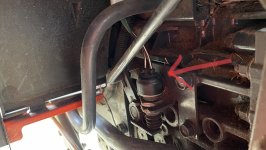DL,
I can understand the confusion. Usually, "jumped" means to add an additional battery, via "jumper cables".
When someone (I) uses the phrase "jump the solenoid" it means to connect the main starter lug, where the big battery cable connects to the starter, to the smaller terminal on the solenoid, which is the terminal that energizes the starter solenoid. Some random piece of metal (screwdriver, metal rod, wrench, remote start switch, small test wire, etc.) is used to make the connection.
The starter solenoid is usually energized by the key, but if one of a multitude of problems occur in the key circuitry, "jumping the solenoid" bypasses all of those problems and directly energizes the solenoid.
PLEASE NOTE: If the tractor is a gear drive and is in gear, and it starts, its GOING TO MOVE! If you are standing in front of a wheel (and you will be, if you are jumping the solenoid) you will probably be run over. Serious injury (my neighbor) or DEATH will result!! Please use extreme caution when jumping the starter solenoid.

